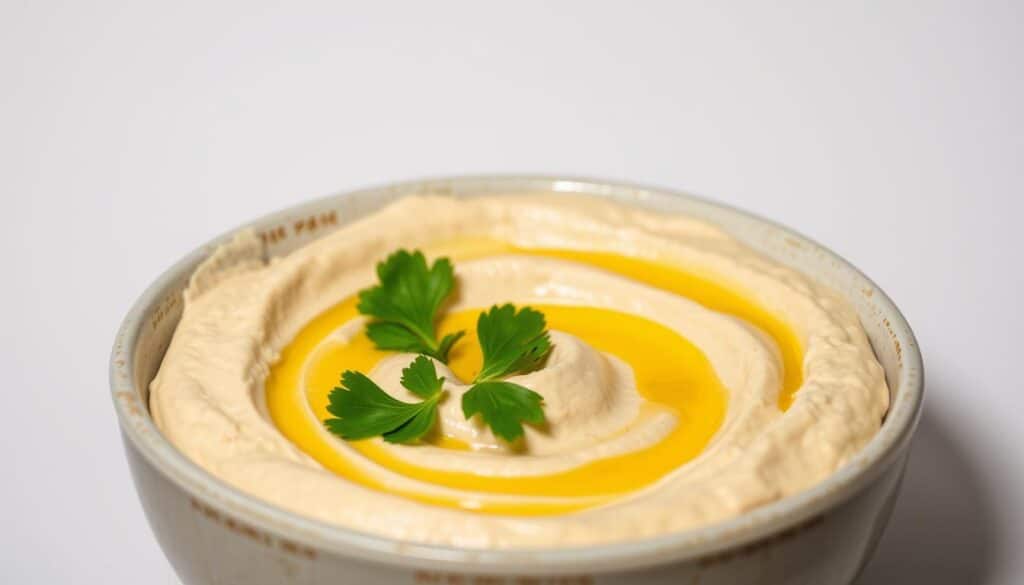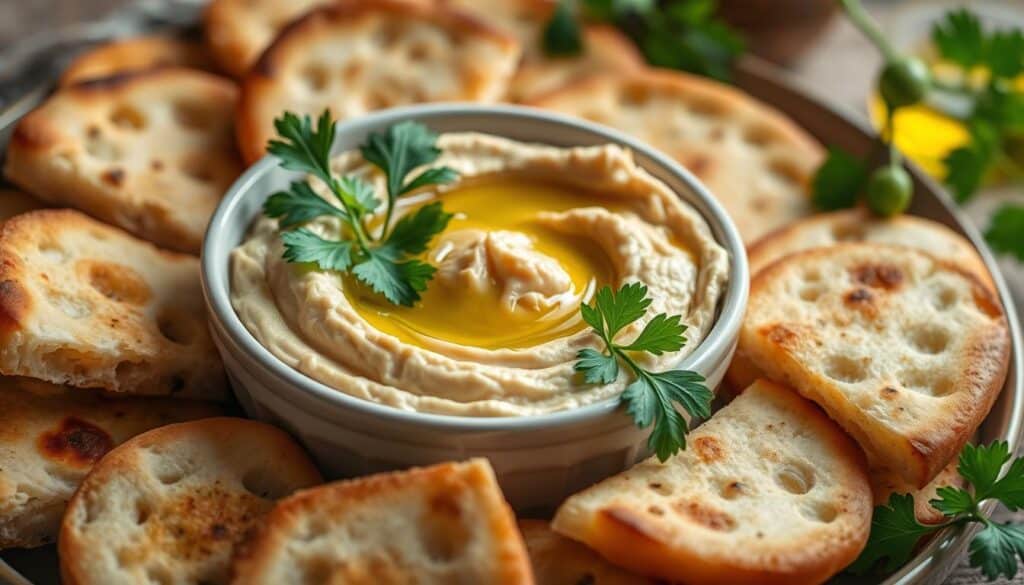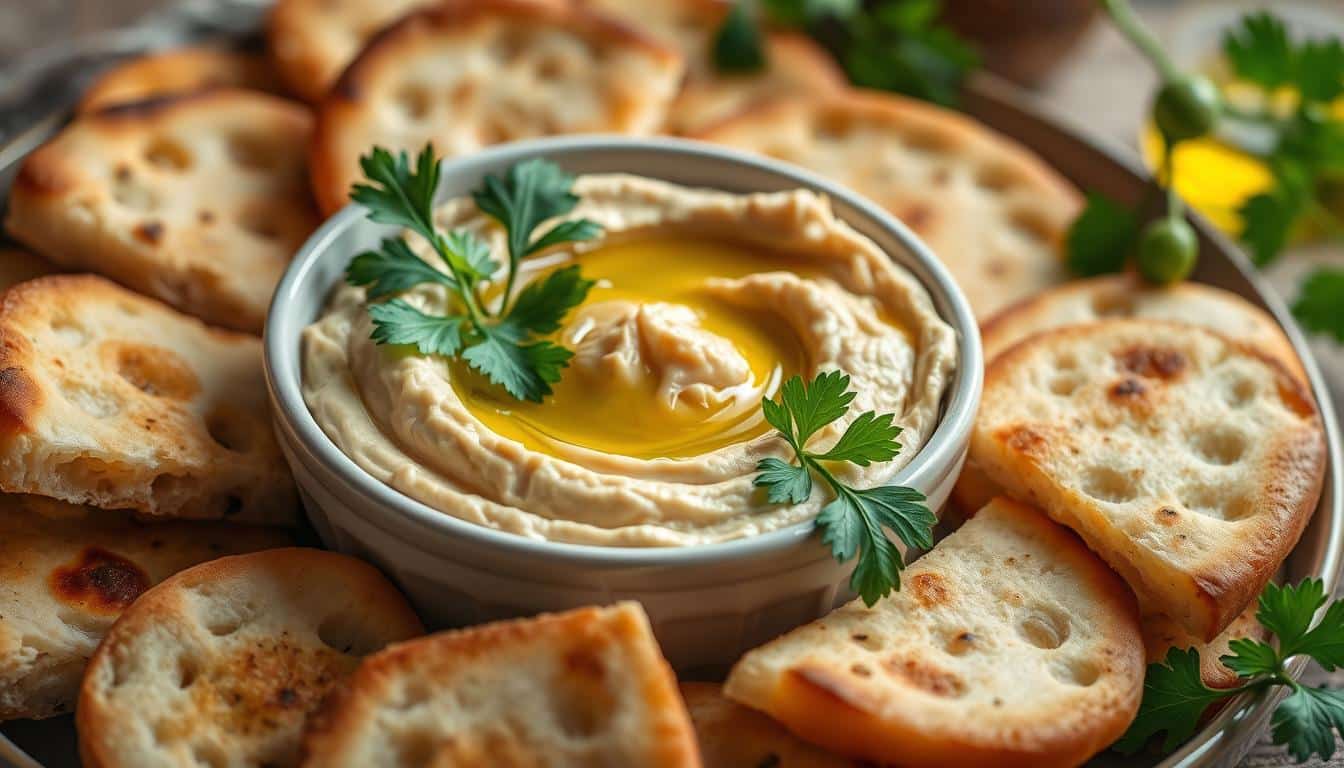There’s something truly special about a bowl of homemade hummus. For me, it’s more than just a dip—it’s a trip back to the cozy afternoons I spent in my grandmother’s kitchen, watching her blend chickpeas, tahini, and lemon juice into a creamy, golden delight. The aroma of fresh ingredients and the sound of the blender created a sense of warmth and togetherness that I carry with me to this day.
Thank you for reading this post, don't forget to subscribe!What makes homemade hummus stand out is the control it gives you over every ingredient. Unlike store-bought versions, you can tweak the amount of lemon juice for brightness or add a drizzle of olive oil for that extra richness. It’s all about creating a smooth, creamy texture that’s hard to resist. The secret? Blending tahini and lemon juice first to form a silky base, then adding chickpeas for a hearty, wholesome dip.

Whether you’re serving it with fresh veggies, crackers, or as a side for dishes like chicken in tomato sauce, homemade hummus is a versatile and flavorful addition to any meal. It’s not just about the taste—it’s about the joy of creating something from scratch, knowing exactly what goes into your food, and sharing that love with the people around you.
Key Takeaways
- Homemade hummus offers better flavor and texture than store-bought options.
- The blending order of ingredients, starting with tahini and lemon juice, is key to a smooth texture.
- You can customize the recipe to your taste with additions like garlic or spices.
- Hummus is versatile and can be paired with a variety of foods for any occasion.
- Making hummus from scratch allows for full control over ingredients and flavor.
Introduction & The Love for Homemade Hummus
Discovering the joy of homemade hummus was a game-changer for me. It’s more than just a dip; it’s about creating something special that brings people together. I remember the first time I made hummus from scratch—it was like unlocking a secret to a flavorful world that store-bought versions just can’t match.
My Personal Journey with Hummus
My love affair with hummus began in my grandmother’s kitchen. Watching her blend chickpeas, tahini, and lemon juice into a creamy delight sparked something in me. Over the years, I’ve experimented with ingredients and techniques, learning what makes each batch unique. It’s amazing how a few simple tweaks can elevate the flavor and texture.
Why I Believe in Homemade Over Store-Bought
Fresh ingredients like garlic and lemon make all the difference. Store-bought hummus can’t compete with the brightness of freshly squeezed lemon juice or the depth of sautéed garlic. Plus, homemade hummus lets me control every ingredient, ensuring each bite is exactly how I like it. It’s not just about taste—it’s about the love and care put into every step of the process.
Every minute spent blending and adjusting is worth it. The smooth texture and vibrant flavors are rewards that store-bought can’t offer. For me, homemade hummus is more than food—it’s a way to share love and connect with others through something truly special.
Ingredients and Tools You Need
Gathering the right ingredients and tools is the first step to creating a delicious homemade dip. Let’s explore what you’ll need to get started.
Essential Ingredients: Chickpeas, Tahini, Lemon Juice, and More
For a classic recipe, you’ll need:
- 1 1/2 cups of cooked chickpeas (or 1 can, drained and rinsed)
- 1/3 cup of tahini
- 1/4 cup of freshly squeezed lemon juice
- 2 garlic cloves, peeled and minced
- 1 teaspoon of salt
- 1/4 cup of water (or more for desired consistency)
These measurements ensure a balanced flavor. For the best taste, use fresh, high-quality ingredients. If you prefer a creamier texture, add an ice cube while blending.
Must-Have Kitchen Tools for a Smooth Blend
A high-quality food processor is essential for achieving a smooth texture. Other helpful tools include:
- A blender for larger batches
- A bowl for mixing ingredients before blending
Using the right tools ensures your dip is well-blended and creamy.
| Ingredient | Measurement | Role |
|---|---|---|
| Chickpeas | 1 1/2 cups | Base ingredient |
| Tahini | 1/3 cup | Texture and flavor |
| Lemon Juice | 1/4 cup | Brightness |
| Salt | 1 teaspoon | Enhances flavor |
| Water | 1/4 cup | Consistency |

With these ingredients and tools, you’re ready to create a delicious homemade dip that’s both nutritious and flavorful. The balance of ingredients and proper tools will ensure a perfect result every time.
Preparation Steps for Perfectly Creamy Hummus
Creating perfectly creamy hummus involves a few simple yet crucial steps. From prepping your ingredients to mastering the blend, each part of the process plays a role in achieving that smooth, velvety texture we all love.
Prepping Chickpeas and Enhancing Flavors
Start by rinsing 1 1/2 cups of chickpeas under cold water. For extra smoothness, you can remove the skins by pinching each chickpea between your fingers. This step is optional but makes a big difference in texture. Add a pinch of salt and let them soak overnight to enhance flavor and tenderness.
Blending Techniques and Texture Secrets
In a processor, blend 1/3 cup of tahini with 1/4 cup of fresh lemon juice for about 2 minutes until silky smooth. Add the chickpeas, 1 teaspoon of salt, and 2 cloves of minced garlic. Blend on high speed for 2 minutes, stopping to scrape down the sides with a spatula if needed.
Gradually pour in 1/4 cup of water while blending. Add more water in small increments if needed to reach your desired consistency. Use a tablespoon to drizzle in olive oil for richness and continue blending until smooth. If using a blender, blend in batches to avoid overloading the machine.
| Step | Action | Purpose |
|---|---|---|
| 1 | Blend tahini and lemon juice | Creates a creamy base |
| 2 | Add chickpeas, salt, garlic | Builds flavor and texture |
| 3 | Gradually add water | Adjusts consistency |
| 4 | Drizzle in olive oil | Enhances richness |
By following these steps, you’ll achieve a creamy, delicious hummus every time. Remember, the key is blending tahini and lemon juice first and adding water slowly for the perfect texture.
Hummus: A dip made with chickpeas tahini and lemon juice, served pita bread.
Creating authentic hummus is an art that blends tradition with simplicity. This timeless dip, born from the heart of Mediterranean cuisine, captures the essence of fresh ingredients and centuries-old techniques. Let’s walk through a step-by-step guide to crafting the perfect hummus recipe while preserving its authentic flavors.
Step-by-Step Recipe Overview
To make homemade hummus, start by blending 1/3 cup of tahini with 1/4 cup of freshly squeezed lemon juice until smooth. Add 1 1/2 cups of chickpeas, 1 teaspoon of salt, and 2 cloves of garlic. Blend on high speed for 2 minutes, then gradually add 1/4 cup of water for consistency. Drizzle in olive oil for richness and continue blending until creamy.
| Step | Action | Purpose |
|---|---|---|
| 1 | Blend tahini and lemon juice | Creates a silky base |
| 2 | Add chickpeas, salt, garlic | Builds flavor and texture |
| 3 | Gradually add water | Adjusts consistency |
| 4 | Drizzle in olive oil | Enhances richness |
Maintaining Authentic Mediterranean Flavors
Authentic Mediterranean hummus relies on ingredients like cumin and paprika for depth. Add a pinch of cumin for warmth and a sprinkle of paprika for a smoky touch. Serve with warm pita bread for an authentic experience, just as it’s done in the Middle East. This homemade approach ensures each bite is filled with love and tradition, setting it apart from store-bought versions.

For a delicious pairing, try serving your hummus alongside chicken shawarma for a flavorful meal. Each ingredient, from the chickpeas to the spices, contributes to a dish that’s both nourishing and delicious.
Serving Suggestions & Creative Variations
Once you’ve crafted your homemade hummus, it’s time to get creative with how you enjoy it. Whether you’re planning a cozy snack or a vibrant gathering, the right presentation and pairings can elevate this simple dip into a star of the show.
Pairing Your Hummus with Warm Pita Bread and Veggies
Warm, freshly baked pita bread is a classic companion for hummus. Tear it into pieces and scoop up the creamy goodness for an authentic experience. Crunchy veggies like carrots, cucumbers, and bell peppers add a refreshing contrast. For a colorful platter, arrange sliced veggies around a bowl of hummus and sprinkle with fresh parsley for a pop of green.
Seasonal and Flavorful Twists
Add some personality to your hummus with seasonal toppings. In the fall, try roasted red peppers for a smoky flavor. During the holidays, garnish with a sprinkle of sumac or paprika for a festive touch. For a lighter option, use it as a spread on whole-grain bread or as a filling in wraps. Experiment with store-bought pita chips for a quick snack, but remember, homemade hummus always shines brightest.
| Pairing | Why It Works |
|---|---|
| Fresh Veggies | Crunchy texture and fresh flavor |
| Warm Pita Bread | Soft, slightly chewy, and perfect for scooping |
| Roasted Red Peppers | Smoky sweetness that complements the dip |
With these ideas, your hummus becomes more than just a dip—it’s a canvas for creativity and a delicious way to bring people together.
Tips and Tricks for the Best Homemade Hummus
Mastering the art of homemade hummus requires a few expert tips and tricks. Whether you’re a seasoned cook or just starting out, these insights will help you refine your technique and achieve the perfect balance of flavor and texture every time.
Using Aquafaba and Adjusting Consistency
Aquafaba, the liquid from canned chickpeas, is a game-changer for achieving a lighter, fluffier hummus. Start by blending 1/4 cup of aquafaba with tahini and lemon juice to create a silky base. For a creamier texture, add a teaspoon of ice-cold water gradually while blending. If using dried chickpeas, soak them for 12-24 hours before cooking to ensure they’re tender and easy to blend.
Garnishing Ideas and Enhancement Techniques
Elevate your hummus with a drizzle of virgin olive oil and a sprinkle of fresh parsley for a vibrant finish. Add a pinch of crushed red pepper for a spicy kick. For a richer flavor, finish with a teaspoon of virgin olive oil. Experiment with roasted garlic or a pinch of cumin to create unique variations that cater to different tastes. These small touches make every serving special and memorable.
For more inspiration, check out this hummus recipe that offers a delicious twist on the classic version. With these tips, you’ll be well on your way to crafting hummus that’s not only delicious but also visually appealing and full of flavor.
Conclusion
Making homemade hummus is more than just a recipe—it’s a journey that connects us to tradition and flavor. By taking the time to blend quality ingredients like chickpeas, tahini, and lemon juice, you create a dip that’s not only delicious but also meaningful. The process is simple, yet each step, from selecting ingredients to blending, contributes to an unbeatable flavor profile.
Using high-quality oil and the right techniques brings out the full potential of your dip. Investing a little time ensures a far superior result compared to store-bought alternatives. Every batch is a testament to creativity and a love for good food. Embrace experimentation and enjoy the process of crafting something special.
Remember, great flavor, proper technique, and a bit of time are all you need for the best dip. For more inspiration, visit this authentic hummus recipe and discover the joy of homemade goodness.
FAQ
What makes homemade hummus creamy and smooth?
The key to a smooth hummus is using fresh chickpeas and blending them with tahini, garlic, and lemon juice in a food processor until silky. A touch of olive oil helps enhance the texture and flavor.
Can I use canned chickpeas for hummus?
Yes, canned chickpeas work well! Just rinse them thoroughly and pat dry to remove excess moisture. This helps achieve the right consistency when blending.
How long should I blend the ingredients?
Blend for about 2-3 minutes, stopping to scrape down the sides of the processor if needed. This ensures everything mixes evenly for a creamy result.
What if my hummus is too thick?
If it’s too thick, add a little water or lemon juice, blending until you reach your desired consistency. A pinch of salt can also balance the flavors nicely.
Can I make hummus without tahini?
While tahini adds a rich, nutty flavor, you can omit it if needed. Just add a bit more olive oil to keep the hummus creamy and delicious.
How should I store homemade hummus?
Store it in an airtight container in the fridge for up to 5 days. Let it come to room temperature before serving for the best taste and texture.
Can I customize hummus with other flavors?
Absolutely! Try adding roasted red peppers for a spicy kick, fresh parsley for freshness, or a sprinkle of cumin for a warm, earthy flavor. The possibilities are endless!
What’s the best way to serve hummus?
Serve it with warm pita bread, fresh veggies, or as a dip for your favorite snacks. It’s also great as a spread on sandwiches or wraps for a tasty twist.
There are no reviews yet. Be the first one to write one.

